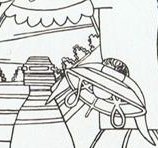Next problem is te kihikihi:
Perhaps Metoro saw the last glyph among the 8 of the first period as a likely place for ashes. Earlier we saw his te kihikihi in front in April 9:
He may have counted from Ca1-19 to the end of August and found number 144 (= 163 - 19), a Sign for the completion of a square of 12. I.e., the natural end for the great Fire in the sky. 99 + 144 = 243 (= 3 * 3 * 3* 3 * 3) = August 31. We should remember how number 243 was connected with rau hei:
40 * 6 = 240 (Moon) and 40 * 9 = 360 (Sun). The 'empty headgear' could symbolize where the King had disappeared (left his constructions):
Possibly marama kua tuu i te kihikihi means how from the 'ashes' of Old Sun a new 'bird of Fire' will rise. In Hevelius' overview of the southern sky we can see the Phoenix constellation at the beginning of Eridanus and depicted as opposite to Crater (perhaps the 'empty head-gear'):
156 (Ca6-16) + 243 = 399 (the synodic cycle of Jupiter). Gregorian day number 243 is August 31 (and day 156 is May 5). | |||||||||||||||||||||||||||||||||||||||||||||||||||||||||||||||||||||||||||||||||||||||||










